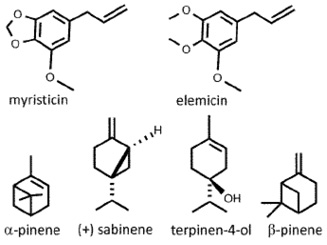 Myristica fragrans
Myristica fragrans
nutmeg • mace
Back to “Spices: mace (Myristica fragrans)sa; nutmeg (Myristica fragrans)s”
Myristica fragrans L. (Myristicaceae); neut, muskaatneut, foelie (Afrikaans); rou dou kou, yu guo hua (Chinese); noix de muscade, fleur de muscade (French); Muskatnuss, Muskatblüte (German); buah pala, sekar pala (Indonesian); meesu, mirisutika (Japanese); noce moscata, mace (Italian); buah pala, sekar pala (Malay); nuez moscada, macis (Spanish); chan thet, dok chan thet (Thai)
DESCRIPTION The ripe, dried and shelled seeds (nutmeg) are about 25 mm (ca. 1 in.) long and 16 mm (1 in.) in diameter, greyish in colour, with a wrinkled surface. They have a spicy flavour and aroma. The hard seeds are easily grated or broken and reveal dark brown oil canals where most of the essential oil is concentrated. The aril around the seed (mace) is net-like and bright red when fresh but pale orange-brown when dried.
THE PLANT An evergreen tree with simple, leathery leaves and small white flowers. Female trees bear smooth, peach-like fruits that split open at maturity. Adulterants and alternatives include Bombay nutmeg (M. malabarica and M. beddomii), Brazilian nutmeg (Cryptocarya moschata) and Madagascar nutmeg (Ravensara aromatica).1
ORIGIN Nutmeg is indigenous to Indonesia.1 The Banda Islands, a group of ten small volcanic islands in the Indonesian province of Maluku, were once the world centre of a monopoly, enforced by successive periods of Portuguese, Dutch, French and British colonial invasions.1 Nutmeg has an interesting history as hallucinogenic drug in Asia and as a spice in Europe, where it became popular around 1100 ad.1 Commercial plantations were established, mainly in Indonesia and Grenada but also in several other tropical regions.1 The annual production has been estimated at 10 000 tons.1
CULTIVATION There is no reliable method of distinguishing between male and female seedlings, so that propagation nowadays relies mostly on grafting. The plant requires wet, tropical conditions and is rarely grown in gardens.
HARVESTING Fruits are hand-picked when ripe and slowly dried, after which the outer shell (fruit wall) is removed, leaving the seed and aril to be sorted and graded.2
CULINARY USES Nutmeg has an exceptionally wide range of culinary uses as a spice.2,3 It is used in ground or grated form (using a nutmeg grater) in sweet and spicy dishes, confectionery, desserts, custards, meat dishes, processed meats, sausages, vegetable dishes and especially potatoes, omelettes and soufflés. It is used in Indonesian soups and sweets, Japanese curry powders, Scottish haggis, Dutch potato and vegetable dishes and French béchamel sauce, mince meat, onion soup and snails.3 Grated nutmeg is also used in fortified wines, mulled wines and cider, eggnog, liqueurs and other alcoholic drinks (e.g. sprinkled on Barbados rum punch). Mace has a more delicate flavour. It is included in spice mixtures and may be used in the same way as nutmeg in sauces and in chicken, fish and pork dishes.2,3
FLAVOUR COMPOUNDS Nutmeg essential oil (5−15% yield) has sabinene, α-pinene, β-pinene and terpinen-4-ol as the main components.4 The distinctive flavour and aroma, however, are ascribed to myristicin (5–8%) and elemicin (2%).4 Mace oil is similar to nutmeg oil in composition but has a higher proportion of myristicin.4

NOTES Myristicin is a psychoactive substance (monoamine oxidase inhibitor) and toxic at high doses; nutmeg and mace should be used sparingly.
1. Flach, M., Willink, M.T. 1989. Myristica fragrans Houtt., pp. 192−196. In: Westphal, E., Jansen, P.C.M. (Eds), Plant resources of South East Asia: a selection. Pudoc, Wageningen.
2. Farrel, K.T. 1999. Spices, condiments and seasonings. Aspen Publishers, Gaithersburg, USA.
3. Larousse. 1999. The concise Larousse gastronomique. Hamlyn, London.
4. Harborne, J.B., Baxter, H. 2001. Chemical dictionary of economic plants. Wiley, New York.